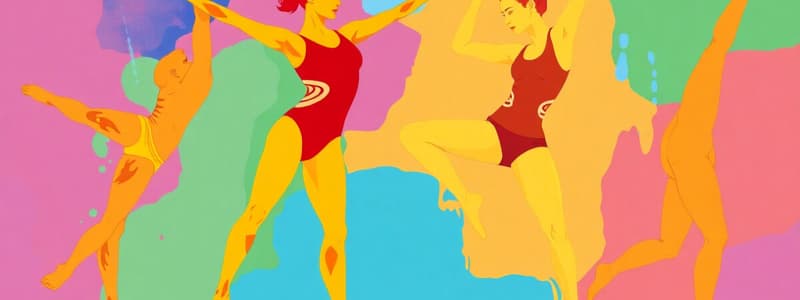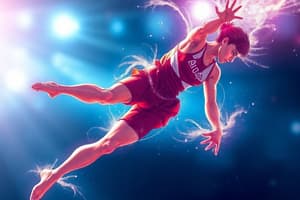Podcast
Questions and Answers
Which personality type prefers a low level of arousal?
Which personality type prefers a low level of arousal?
- Neither
- Both
- Introvert (correct)
- Extrovert
What is a common characteristic associated with introverts?
What is a common characteristic associated with introverts?
- Sociable and enjoys interacting with others
- Prefers solitary activities (correct)
- Often becomes bored when alone
- Thrives in exciting situations
Which type of sport is commonly associated with extroverts?
Which type of sport is commonly associated with extroverts?
- Sports with a high level of skill and accuracy
- Team sports with a fast pace (correct)
- Individual sports requiring precision
- Sports requiring a high level of concentration
What is defined as the drive to succeed or achieve something?
What is defined as the drive to succeed or achieve something?
What is 'intrinsic motivation'?
What is 'intrinsic motivation'?
Which type of reward is categorized as 'tangible'?
Which type of reward is categorized as 'tangible'?
What is a benefit of having a strong intrinsic motivation?
What is a benefit of having a strong intrinsic motivation?
Which type of motivation is generally considered more powerful and lasting?
Which type of motivation is generally considered more powerful and lasting?
What does physical arousal refer to in the context of performance?
What does physical arousal refer to in the context of performance?
Which of the following sports may require higher arousal levels to enhance performance?
Which of the following sports may require higher arousal levels to enhance performance?
According to the Inverted U Theory, what happens if an athlete is over-aroused?
According to the Inverted U Theory, what happens if an athlete is over-aroused?
What technique is NOT mentioned as a method for controlling arousal levels?
What technique is NOT mentioned as a method for controlling arousal levels?
How does deep breathing help an athlete?
How does deep breathing help an athlete?
Which athlete is associated with using mental rehearsal to control arousal levels?
Which athlete is associated with using mental rehearsal to control arousal levels?
What is the primary benefit of positive self-talk for athletes?
What is the primary benefit of positive self-talk for athletes?
What is the purpose of visualisation in sports performance?
What is the purpose of visualisation in sports performance?
What distinguishes a skill from an ability?
What distinguishes a skill from an ability?
Which type of skill requires precise movements with small muscle groups?
Which type of skill requires precise movements with small muscle groups?
How does an open skill differ from a closed skill?
How does an open skill differ from a closed skill?
Which description best aligns with self-paced skills?
Which description best aligns with self-paced skills?
Which characteristic describes complex skills?
Which characteristic describes complex skills?
Which skill type is primarily influenced by an unstable environment?
Which skill type is primarily influenced by an unstable environment?
What type of skill typically involves larger muscle groups and less emphasis on precision?
What type of skill typically involves larger muscle groups and less emphasis on precision?
Which of the following is NOT a classification of skills?
Which of the following is NOT a classification of skills?
Flashcards
Skill
Skill
The ability to perform a task consistently and accurately using the correct technique, acquired through practice and repetition.
Ability
Ability
A natural, inherited talent or predisposition that influences a person's performance in a specific area.
Open Skill
Open Skill
Skills performed in an unpredictable environment, where the execution is influenced by external factors.
Closed Skill
Closed Skill
Signup and view all the flashcards
Fine Skill
Fine Skill
Signup and view all the flashcards
Gross Skill
Gross Skill
Signup and view all the flashcards
Self-Paced Skill
Self-Paced Skill
Signup and view all the flashcards
Externally Paced Skill
Externally Paced Skill
Signup and view all the flashcards
Personality
Personality
Signup and view all the flashcards
Introvert
Introvert
Signup and view all the flashcards
Extrovert
Extrovert
Signup and view all the flashcards
Motivation
Motivation
Signup and view all the flashcards
Intrinsic Motivation
Intrinsic Motivation
Signup and view all the flashcards
Extrinsic Motivation
Extrinsic Motivation
Signup and view all the flashcards
Tangible reward
Tangible reward
Signup and view all the flashcards
Intangible reward
Intangible reward
Signup and view all the flashcards
Arousal
Arousal
Signup and view all the flashcards
Inverted U Theory
Inverted U Theory
Signup and view all the flashcards
Physical signs of arousal
Physical signs of arousal
Signup and view all the flashcards
High Arousal Sports
High Arousal Sports
Signup and view all the flashcards
Low Arousal Sports
Low Arousal Sports
Signup and view all the flashcards
Arousal Control Techniques
Arousal Control Techniques
Signup and view all the flashcards
Positive Self-Talk
Positive Self-Talk
Signup and view all the flashcards
Mental Rehearsal
Mental Rehearsal
Signup and view all the flashcards
Study Notes
Skill and Ability
- Skills are learned and performed consistently using correct technique.
- Abilities are inherited traits that remain relatively stable throughout life.
- Abilities help people learn skills.
The Beam
- Balance is an inherited ability that allows gymnasts to develop beam skills more easily.
- Practicing is necessary to achieve technically sound handstand splits on the beam.
Types of Skill
- Skills can be classified as closed or open.
- Closed skills are performed in a stable environment, while open skills are performed in an unstable environment.
- Skills can be fine or gross.
- Fine skills involve small, precise movements and small muscle groups, requiring precision and accuracy.
- Gross skills involve large body movements and large muscle groups, not needing precision.
- Skills can be self-paced or externally paced.
- Self-paced skills are controlled by the performer, whereas externally paced skills are influenced by outside factors.
- Skills can be basic or complex.
- Basic skills require few decisions and are often taught to beginners.
- Complex skills involve many decisions and take considerable time to master.
Inverted U Theory
- Arousal is a physical and mental state of alertness and excitement.
- Physical manifestations include increased heart rate and sweating,.
- Athletes need to control arousal levels to maintain optimal performance.
- Yerkes-Dodson law: optimal performance happens at medium arousal. Too high or too low arousal hinders performance.
Arousal Levels
- Some sports need higher arousal levels (e.g., rugby tackling).
- Other sports need lower arousal levels (e.g., cricket fielding) to concentrate.
Controlling Arousal
- Techniques like self-talk, visualisation, and deep breathing can help manage arousal.
- Examples of athletes who use these techniques include Ronaldo, Jonny Wilkinson, Serena Williams.
- Specific examples include Ronaldo using deep breathing, Jonny Wilkinson using mental rehearsal, and positive self-talk for other athletes.
Descriptions
- Deep Breathing: A physical technique involving controlled breathing to manage arousal.
- Mental Rehearsal: A tool similar to visualization where performers mentally rehearse a skill to prepare for their performance.
Personality
- Sport psychologists study athlete personality to understand differences.
- Personality categories include introverts and extroverts.
Personality = Introvert or Extrovert
- Introverts typically don't require high arousal levels, tend to be shy, quiet, and thoughtful.
- Introverts commonly choose individual sports that involve fine skills.
- Extroverts require high arousal levels, are more sociable, and can lack concentration.
- Extroverts typically excel in team sports requiring gross motor skills and a fast pace.
Motivation
- Motivation is the drive to succeed or the desire to achieve something.
- Motivation can be classified as intrinsic or extrinsic.
Intrinsic and Extrinsic Motivation
- Intrinsic motivation comes from within the performer, leading to feelings of pride, satisfaction, and general achievement.
- Extrinsic motivation comes from outside sources, such as rewards (tangible or intangible) from others.
- Intrinsic and extrinsic motivations can work together.
Studying That Suits You
Use AI to generate personalized quizzes and flashcards to suit your learning preferences.




